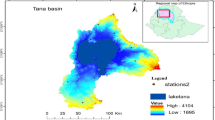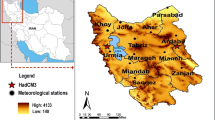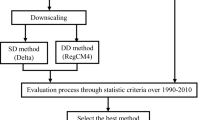Abstract
The outputs from general circulation models (GCMs) lack spatial and temporal accuracy for local and regional studies due to their large-scale networks. Therefore, there is a need to make the scale of outputs from these models smaller to the station and point scales. This has led to the development of regional and statistical models that have wide applications in climate change studies from the beginning of their introduction and decision-making for facing and adapting to the consequences of climate change in recent years. The models based on statistical methods are more popular and applicable due to their ease of use and because they do not need high computational power. Among the statistical methods, LARS-WG and SDSM are the most commonly used and valid downscaling models. In this study, the results of our analysis related to the performance of these two models in simulating temperature and precipitation changes in western Iran are presented. The weather stations under study include 17 stations with a long-term statistical period (1989–2018) in three provinces of Kurdistan, Kermanshah, and Ilam. To evaluate the performance of the models, MSE, RMSE, MAE, and R2 are used. The results show that the two models have an acceptable level of ability in simulating temperature and precipitation changes in the area under study. However, different results are reported for different stations and within different weather parameters. A comparison between the performance of the two models in simulating temperature and precipitation changes reveals that both of them have higher accuracy in simulating temperature than precipitation. Furthermore, the SDSM model is more successful in a monthly simulation of temperature and precipitation with lower uncertainty. However, it has a time-consuming and complicated simulation process. The LARS-WG model is more efficient in simulating annual precipitation and is simpler with a higher performance speed. In a nutshell, none of these models is better than the other and despite the differences in simulation, they can both be useful for examining climate changes. There is a need to use different models for examining the uncertainty of climate change.







Similar content being viewed by others
References
Ababaei B, Mirzaei F, Sehrabi T (2011) An evaluation of the performance of the LARS-WG model in 12 coastal stations of Iran. Iran Water Res 5(9):217–222
Abkar A, Habib Nejad M, Soleimani K, Naghavi N (2013) Examining the level of efficiency of the SDSM model in simulating temperature indices in the arid and semi-arid areas. Irrig Water Eng 4(14):1–17
Aghashahi M, Ardestani M, Niksokhan MH, Tahmasbi B (2012) Introducing and comparing LARS-WG and SDSM models to down-scale environmental parameters in climate change studies. In: Sixth National Specialized Environmental Engineering Conference and Exhibition, Tehran, p 10
Carter TR, Parry ML, Harasawa H, Nishioka S (1994) IPCC technical guidelines for assessing climate change impacts and adaptions, IPCC Special Report to Working Group II of IPCC, London
Goudarzi M, Salahi B, Hosseini SA (2015) Performance analysis of LARS-WG and SDSM downscaling models in simulation of climate changes in Urmia Lake Basin. Iran J Watershed Manag Sci Eng 9(31):11–22
Hajjarpour A, Yousefi M, Kamkar B (2014) Testing the accuracy of the simulation by LARS-WG, WeatherMan, and CLIMGEN models in simulating climatic parameters in three different climates (Gorgan, Gonbad, and Mashhad). Geogr Dev 35:201–215
Hashmi MZ, Shamseldin AY, Melville BW (2010) Comparison of SDSM and LARS-WG for simulation and downscaling of extreme precipitation events in a watershed. Stoch Environ Res Risk Assess 25:475
Helali J, Salimi S, Lotfi M, Hosseini SA, Bayat A, Ahmadi M, Naderizarneh S (2020) Investigation of the effect of large-scale atmospheric signals at different time lags on the autumn precipitation of Iran’s watersheds. Arab J Geosci 13(18):1–24
Heydari Tasheh Kabood SH, Hosseini SA, Heydari Tasheh Kabood A (2020) Investigating the effects of climate change on stream flows of Urmia Lake basin in Iran. Model Earth Syst Env 6(1):329–339
Houshyar M, Sobhani B, Hosseini SA (2018) Future projection of maximum temperature in Urmia through downscaling output of the CanESM2 Model. Geogr Plan 22(63):305–325
Hu TS, Lam KC, Ng ST (2001) River flow time series prediction with a range-dependent neural network. Hydrol Sci J 46:729–745
IPCC (2001) In: Watson RT, Zinyowera MC, Moss RH, Dokken DJ (eds) Special report on the regional impacts of climate change, an assessment of vulnerability. Cambridge University Press, Cambridge
IPCC (2007) Summary for policymakers, in climate change 2007. In: Solomon S, Qin D, Manning M, Chen Z, Marquis M, Averyt KB, Tignor M, Miller HL (eds) Climate change 2007: the physical science basis, contribution of working group I to the fourth assessment report of the intergovernmental
Khan MS, Coulibaly P, Dibike Y (2006) Uncertainty analysis of the statistical downscaling method. J Hydrol 319:357–382
Lin JY, Cheng CT, Chau KW (2006) Using support vector machines for long-term discharge prediction. Hydrol Sci J 51:599–612
Ouji R (2018) Comparing mono-station and multi-stational downscaling of temperature and precipitation extremes (a case study of southern coasts of the Caspian Sea). J Earth Space Phys 44(2):397–410
Qian B, Gameda S, Hayhoe H, DeJong R, Bootsma A (2004) Comparison of LARS-WG and AAFC-WG stochastic weather generators for diverse Canadian climates. Clim Res 2004:26
Salahi B, Goudarzi M, Hosseini SA (2017) Predicting the temperature and precipitation changes during the 2050s in Urmia Lake Basin. Watershed Eng Manag 8(4):425–438
Salimi S, Balyani S, Hosseini SA, Momenpour SE (2018) The prediction of the spatial and temporal distribution of precipitation regime in Iran: the case of Fars province. Model Earth Syst Env 4(2):565–577
Semenov M, Brooks R, Barrow E, Richardson C (1998) Comparison of the WGEN and LARS-WG stochastic weather generators for diverse climates. Clim Res 10:95–107
Semonov MA, Stratonovitch P (2010) Use of multi-model ensembles from global climate models for assessment of climate change impacts. Clim Res 41:1–14
Shamsipour AA (2013) Climatic modeling: theory and method. In: University of Tehran Publications, first edition, p 294
Sharma D, Gupta AD, Babel MS (2007) Spatial disaggregation of bias-corrected GCM precipitation for improved hydrologic simulation: Ping River Basin, Thailand. Hydrol Earth Syst Sci 11:1373–1390
Sobhani B, Eslahi M, Babaeian I (2017) Comparing the methods of statistical downscaling of climate change models in simulating climatic elements in the northwest of Iran. Natural Geogr Res 4(2):321–325
Sunyer MA, Hundecha Y, Lawrence D, Madsen H, Willems P, Martinkova M, Vormoor K, Bürger G, Hanel M, Kriaučiūnienė J, Loukas A, Osuch M, Yücel I (2015) Inter-comparison of statistical downscaling methods for projection of extreme precipitation in Europe. Hydrol Earth Syst Sci 19:1827–1847
Tabataba-ei H, Hoseini M (2003) Examining climate change in Semnan based on precipitation parameters and mean monthly temperature. In: Third Regional Conference and the First National Conference on Climate Change, Isfahan, Iran
Wigley TWL, Jones PD, Briffa KR, Smith G (1990) Obtaining sub-grid scale information from coarse resolution general circulation model output. J Geophys Res 951:1943–1953
Wilby RL, Dawson CW, Barrow EM (2002) SDSM- a decision support tool for the assessment of regional climate change impacts. Environ Model Softw 17:147–159
Wilks DS (1992) Adapting stochastic weather generation algorithms for climate change studies. Clim Change 22:67–84
Wilks DS, Wilby RL (1999) The weather generation game: a review of stochastic weather models. Prog Phys Geogr 23:329–357
Author information
Authors and Affiliations
Corresponding author
Additional information
Publisher's Note
Springer Nature remains neutral with regard to jurisdictional claims in published maps and institutional affiliations.
Rights and permissions
About this article
Cite this article
Lotfi, M., Kamali, G.A., Meshkatee, A.H. et al. Performance analysis of LARS-WG and SDSM downscaling models in simulating temperature and precipitation changes in the West of Iran. Model. Earth Syst. Environ. 8, 4649–4659 (2022). https://doi.org/10.1007/s40808-022-01393-8
Received:
Accepted:
Published:
Issue Date:
DOI: https://doi.org/10.1007/s40808-022-01393-8




